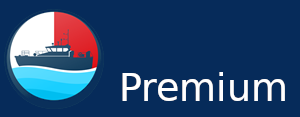Join the conversation...
By the way: Your sample with the car is failing this most important effect I was talking about: If you would have very strong wind from abeam then even a car would need a drift angle and an additional steering wheel angle to compensate the wind effect – much stronger than the normal corrective steering you mentioned.
Finally I like to thank you for your offer to the academics / hydrodynamicists - I would be open for any remaining question and kind of ideas... Maybe you could have a look on our YouTube platform (search for ISSIMS) where are more movies which might be of help – the next one will be on wind effect on turning circles…
I am an active marine pilot, and for me this video has a practical use! Therefore I would like to point out that you should not speak for everyone here ("basically this video tells us nothing at all"). I believe that the people on this platform are able to develop own opinions and assessments.
I have experience as an instructor and I know that it is a proven method to investigate effects first separately. Only after single effects/forces have been understood, it makes sense to become more complex (with your words "variable forces"). For example, if you want to train a boxer, you start with individual techniques and footwork before everything comes together in sparring. There are just different levels of professional development in training.
In our case of ship operations, mathematical theories and models make the difference between our ancestors in their rowing boats and today's modern technology. Such mathematical models are the accepted background of every modern simulation, no matter which manufacturer. In my opinion a denial of such models means the denial of scientific knowledge and stands for backward thinking.
If you have constructive ideas, questions and remarks, it could be an option for you to contact the author directly on youtube. Maybe he is even not aware that his video was posted here.
Capt. Marko Purwin
For those who don't drive ships try driving your car with a constant steering position. Even on a desert road running straight and level for as far as the eye can see you can't just let go of the steering wheel and stay on the road. The driver is constantly making small adjustments.
Add to that the complications of narrow channels and an uneven bottom and you are already outside the known math models.
Lastly, every ship is different, every rudder is different and even the same ship can have an infinite variety of steering conditions depending on the current, wind, trim by the bow or stern and how deeply she is loaded. A pilot can come inbound on a ship and sail out the next day on the same vessel and she will steer totally differently.
If hydrodynamicists would like a useful project, give pilots a way to predict which ships will steer easily and which ones arrive at the sea buoy at the limit of controllability. I bet every pilot on this forum has had ships that made their hair stand on end. We only found out when making the first turn of the transit that she would begin turning sweetly but full over rudder was barely enough to stop her from turning. I have my ideas but it would be off topic. Let's see if any of the academics contact me about it.
Video How Ship Anchor Works? - Procedure For Anchoring a Ship at Sea
published on 11 July 2020
#Anchor #shipanchor #windlass Anchoring is one of the very frequent operations onboard ships. A number of variables and external factors influence the duration and location of an anchoring operation. While the type of seabed is of utmost importance during anchoring, soft muddy grounds or clay bottoms are best preferred. It should be taken care that the anchoring bottom is free of power lines, submarine cables, pipelines or rocks. Various methods on anchoring include consideration of...
Video How port pilot sail out ship from the port? Grimaldi lines catania roro ship
published on 22 April 2022
Article Psychophysical stress and strain of maritime pilots in Germany. A cross-sectional study
published on 12 June 2021
Article A review of the ship’s pivot point: Science, Maths and Observation’ Where is the centre of a ship’s rotation?
by Tim Cummins, Harbour Pilot, Portsmouth International Port - published on 17 July 2020
This my attempt to do just that. This is a summary of all scientific papers and articles that I could find about the ship’s pivot point. I have added links to any videos associated with the publications and have also included any useful diagrams or equations that the authors published to help explain their research.


